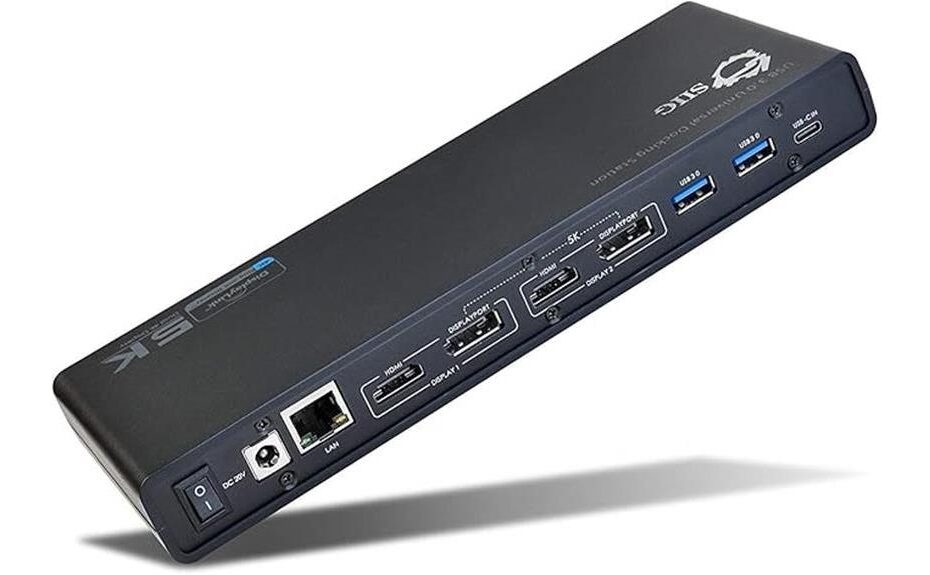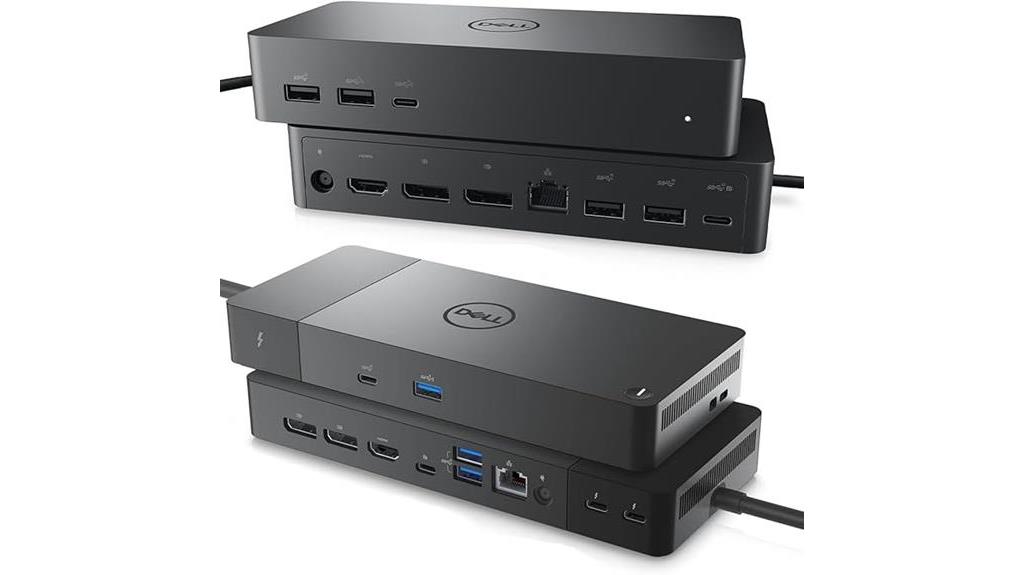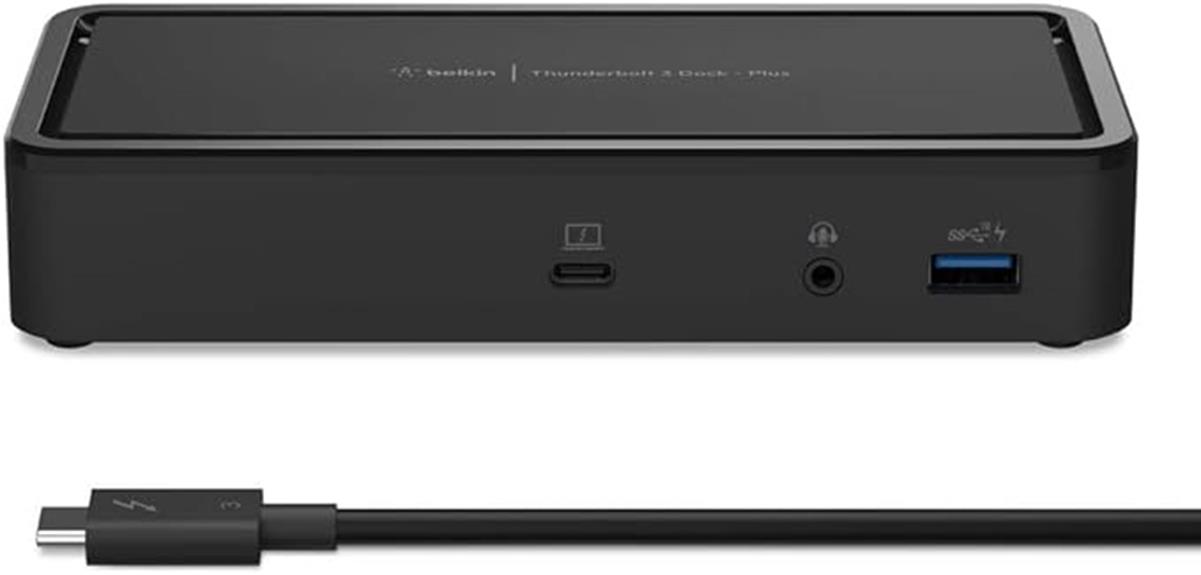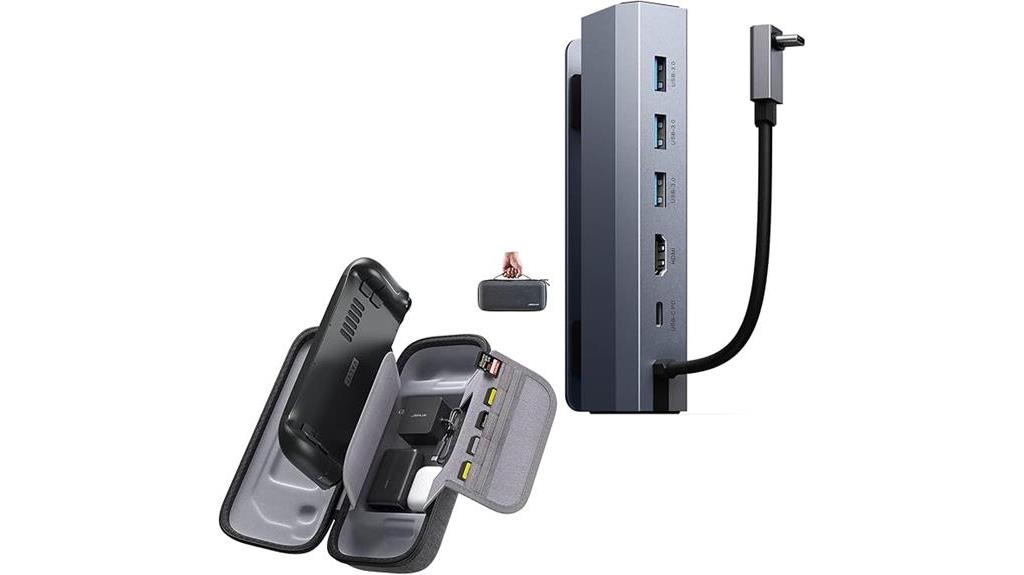


I find the SIIG USB Type C Docking Station to be a powerful tool for boosting productivity. It supports dual 4K displays at 60Hz and has six USB 3.0 ports, which are great for multitasking. However, I've encountered some installation challenges, especially with drivers, and performance can lag with multiple monitors. The build quality is solid, but the design could be more modern. Overall, it offers excellent connectivity for remote workers and gamers alike. If you're considering this product, you'll want to weigh its advantages against a few drawbacks to make an informed decision.
Key Takeaways
- The SIIG USB Type C Docking Station supports dual 4K displays at 60Hz, enhancing multitasking and productivity for users.
- It features six USB 3.0 ports and a Gigabit Ethernet port for reliable connections and fast data transfer.
- Users report performance issues, particularly lag during dual monitor use, affecting multitasking efficiency.
- Driver installation can be challenging, especially for laptops without CD drives, leading to setup frustrations.
- Overall, the dock offers great functionality but may require careful consideration of performance and compatibility concerns.
When evaluating the SIIG USB Type C Docking Station, I often find that its high-resolution capabilities stand out prominently. The dock design effectively supports dual 4K displays or a single 5K monitor, which is impressive for anyone needing extensive screen real estate. However, I can't overlook the performance issues that some users have reported. Many experience lag when running multiple monitors, particularly with DisplayLink technology, which can detract from the experience. Although the dock's aesthetic and functionality are commendable, these performance drawbacks raise concerns, especially for those relying on seamless multitasking. It's essential to weigh the benefits of high-resolution output against the potential for frustrating performance hiccups that could impact productivity.
Features and Benefits
The SIIG USB Type C Docking Station offers impressive features like dual 4K display support and six USB 3.0 ports, which enhance my productivity by allowing multiple high-resolution outputs and device connections simultaneously. I appreciate the inclusion of a Gigabit Ethernet port for fast and reliable networking. However, I've encountered some challenges with driver installation, particularly for users with newer laptops lacking CD drives.
Dual 4K Display Support
With the increasing demand for higher resolution displays, the SIIG USB Type C Docking Station stands out for its robust support of dual 4K displays at 60Hz. This feature greatly enhances my productivity, allowing me to multitask effectively on a larger interface. The performance optimization offered by the dual display configuration guarantees that I can run multiple applications simultaneously without noticeable lag. I appreciate how easy it is to switch between various display setups, whether using HDMI or DisplayPort outputs. This flexibility caters to my specific needs, whether I'm working on design projects or streaming high-definition content. Overall, the dual 4K display support elevates my user experience, making this docking station a valuable asset in my tech arsenal.
Six USB 3.0 Ports
Having access to six USB 3.0 ports on the SIIG USB Type C Docking Station greatly enhances my ability to connect multiple devices simultaneously. These USB ports provide significant USB port benefits, such as faster data transfer rates and the convenience of connecting various peripherals like external drives, keyboards, and mice without hassle. I've noticed that this feature is especially useful when I'm working on projects that require extensive file management across devices. The docking station's broad device compatibility guarantees that I can use it with both my laptop and desktop, regardless of brand. Overall, the six USB 3.0 ports streamline my workflow, allowing me to work efficiently without constantly swapping cables.
Gigabit Ethernet for Fast Networking
When it comes to reliable internet connectivity, the Gigabit Ethernet port on the SIIG USB Type C Docking Station stands out as an vital feature. I've found that this port considerably enhances my network speed, providing a stable and fast connection that's critical for tasks like video conferencing and large file transfers. Unlike typical Wi-Fi connections, the ethernet advantages are evident; I experience fewer interruptions and consistent performance, which is especially beneficial when working from home. The docking station effortlessly integrates into my setup, eliminating the frustration of unreliable wireless connections. Overall, the Gigabit Ethernet capability not only boosts my productivity but also guarantees that I can rely on a robust internet connection whenever I need it.
Driver Installation Challenges
Many users encounter notable driver installation challenges with the SIIG USB Type C Docking Station, which can complicate the initial setup process. I found that the lack of a CD drive in newer laptops makes it vital to download the necessary drivers from the DisplayLink website. This reliance on online resources can lead to confusion, especially regarding driver compatibility with various operating systems. Additionally, installation support can be inconsistent, leaving users uncertain about which version to download. I experienced performance issues myself, particularly when using multiple monitors, which can often stem from improper driver installation. Overall, addressing these driver installation challenges is fundamental for maximizing the docking station's potential and ensuring a smooth user experience.
Product Quality
Evaluating the product quality of the SIIG USB Type C Docking Station reveals both strengths and weaknesses. The build quality is solid; the device feels sturdy and well-constructed, which gives me confidence in its durability. However, the design aesthetics are somewhat lacking. While it has a functional look, it doesn't stand out regarding style, which may not appeal to everyone. The layout of ports is practical, but I found it a bit crowded, making it challenging to connect multiple devices simultaneously. Overall, while the docking station performs its intended functions well, the design could benefit from a more modern touch that aligns with the sleek nature of today's tech devices.
What It's Used For
I use the SIIG USB Type C Docking Station primarily for setting up dual monitors, which greatly enhances my productivity. Its high-resolution video output supports stunning visuals, whether I'm working on graphic design or streaming content. Additionally, the range of connectivity options allows me to connect various devices seamlessly, making it an essential tool in my workspace.
Dual Monitor Setup
A dual monitor setup greatly enhances productivity by providing more screen real estate for multitasking. I've found that having two screens allows me to keep important applications visible while I work on other tasks. Proper monitor alignment is essential for a seamless experience; I make sure both displays are calibrated to the same height and angle, which reduces neck strain and improves focus. The SIIG USB Type C Docking Station delivers impressive display performance, supporting dual 4K outputs at 60Hz. This capability guarantees that my visuals are crisp and fluid, whether I'm editing videos or conducting research. Overall, integrating a dual monitor setup into my workspace has considerably streamlined my workflow and increased my efficiency.
High-Resolution Video Output
The ability to output high-resolution video is a game-changer for various tasks, from graphic design to gaming. With the SIIG USB Type C Docking Station, I can enjoy stunning video resolution thanks to its support for dual 4K@60Hz or a single 5K@60Hz output. This capability considerably enhances my workflow, allowing me to work on multiple projects simultaneously without sacrificing quality. The display compatibility is impressive as it supports various configurations through HDMI and DisplayPort outputs. Whether I'm editing high-definition videos or gaming at ultra settings, this docking station provides crisp visuals and vibrant colors. Overall, the high-resolution video output elevates my experience, making it an essential tool for anyone who values superior visual performance.
Enhanced Connectivity Options
Enhanced connectivity options with the SIIG USB Type C Docking Station greatly streamline the user experience, especially for those juggling multiple devices. With its impressive port variety, including six USB 3.0 ports, two HDMI, and two DisplayPort outputs, I can easily connect my laptop to various peripherals, enhancing productivity. This versatility allows me to switch between my keyboard, mouse, and external drives without hassle. The Gigabit Ethernet port guarantees reliable network access, making it perfect for video conferencing or large file transfers. Plus, its broad device compatibility with Windows and Intel-based Mac systems means I don't have to worry about whether my devices will work seamlessly together. Overall, it really simplifies my setup.
Product Specifications
When exploring the SIIG USB Type C Docking Station, it is crucial to understand its thorough specifications that enhance its functionality. The specifications provide insight into potential compatibility issues and performance concerns users might face.
| Feature | Specification | Notes |
|---|---|---|
| Video Output | Dual 4K@60Hz or single 5K@60Hz | Requires appropriate monitor setup |
| USB Ports | 6 USB 3.0 Ports | Supports multiple devices simultaneously |
| Ethernet Port | Gigabit Ethernet | Guarantees reliable network connectivity |
| Compatibility | Windows 10/8/7/Vista/XP, Mac OS X | Intel-based Macs may experience issues |
Who Needs This
Who would benefit from using the SIIG USB Type C Docking Station? If you're engaged in remote work, this docking station is a game-changer. It simplifies connections for multiple devices, allowing me to quickly switch from my laptop to dual 4K monitors. This means I can manage my tasks more efficiently without the hassle of unplugging and replugging cables. Additionally, gamers will find it particularly useful for setting up an all-encompassing gaming setup, as the dual monitor support enhances the overall experience. The six USB 3.0 ports let me connect peripherals seamlessly, too. Essentially, whether you're working from home or diving into an intense gaming session, this docking station caters to your needs effectively.
Pros
The SIIG USB Type C Docking Station offers several advantages that cater to both productivity and entertainment needs. First and foremost, the design benefits of dual 4K support allow me to enhance my workspace with crisp visuals, making multitasking a breeze. In addition, the abundance of ports—six USB 3.0 and two HDMI/DisplayPort—provides incredible user convenience, enabling me to connect multiple devices without hassle. Finally, the embedded Gigabit Ethernet port guarantees I get reliable network connectivity, which is critical for seamless online activities. Overall, this docking station effectively combines functionality and aesthetics, making it a valuable addition to my tech setup.
Cons
While the SIIG USB Type C Docking Station boasts impressive features, it does come with several drawbacks that potential users should consider. I've noticed a few key cons that stand out:
- Performance issues: I've experienced lagging when using multiple monitors, which can be frustrating during intensive tasks.
- Driver compatibility: Setting it up requires downloading drivers, especially since newer laptops lack CD drives. This has been a hassle for many users, including myself.
- Limited support for certain devices: Specific models, like the MacBook Pro 2018, face issues that require additional tweaks for ideal performance.
What Customers Are Saying
Customer feedback on the SIIG USB Type C Docking Station reveals a mix of satisfaction and frustration. Many customers share positive experiences regarding the design and functionality, appreciating the sleek look and multiple ports that enhance connectivity. However, performance feedback often highlights issues with lagging, especially when using dual monitors. Users have expressed frustration with the setup process, particularly those lacking CD drives to install necessary drivers. Additionally, MacBook Pro users report compatibility challenges, needing specific drivers for peak performance. Overall, while some users are pleased with the docking station's capabilities, the recurring performance concerns and setup difficulties are evident in their reviews, leading to a divided perspective on its effectiveness.
Overall Value
Amidst the mixed customer feedback, evaluating the overall value of the SIIG USB Type C Docking Station reveals both strengths and weaknesses. On one hand, its high-resolution capabilities and extensive connectivity options make it a versatile choice for users needing multiple displays. However, the user experience often suffers due to performance lags and setup challenges, particularly with driver installations. This inconsistency can overshadow its competitive pricing strategy, which aims to attract budget-conscious consumers. Given the 3.8-star rating and customer comments focusing on functionality versus performance, I find the value proposition to be somewhat tenuous. While it offers significant features, potential buyers should weigh these against the practical concerns raised by existing users before making a decision.
Tips and Tricks For Best Results
To achieve the best results with the SIIG USB Type C Docking Station, there are a few essential tips to keep in mind. First, make sure you download the latest DisplayLink drivers from their website; this dramatically improves user experience and can resolve many performance issues. Next, if you're using dual monitors, connect them via HDMI or DisplayPort carefully to optimize performance. It's also wise to connect directly to your laptop's USB-C port instead of using hubs to prevent lag. Finally, consider using a wired Ethernet connection for more stable internet access. By following these tips, I've noticed significant enhancements in both connectivity and overall performance optimization, making my setup much more efficient.
Conclusion
In evaluating the SIIG USB Type C Docking Station, it's clear that it offers a robust solution for users needing high-resolution displays and multiple connections. The dock design stands out with its thoughtful layout, providing ample ports that cater to a variety of devices. However, my user experience revealed some challenges, particularly with setup and compatibility. While the dual 4K output is impressive, I encountered performance issues when using multiple monitors, likely due to DisplayLink technology. This dock is ideal for users who prioritize connectivity but may require patience with driver installations. Overall, I find it a valuable tool for enhancing productivity, but potential buyers should weigh the pros and cons based on their specific needs.
Frequently Asked Questions
What Types of Monitors Are Compatible With the Docking Station?
I've found that the docking station supports various monitor resolutions. It accommodates dual 4K displays or a single 5K monitor, depending on the display configuration, ensuring I get the best visual experience possible.
Can I Use the Docking Station With a Chromebook?
I've found that Chromebook compatibility largely hinges on USB C functionality. While many Chromebooks support USB-C docking, I'd recommend checking specific model compatibility to guarantee seamless performance with dual monitor setups and additional peripherals.
How Do I Troubleshoot Connectivity Issues?
When troubleshooting connectivity issues, I check USB connectivity first. If the docking performance lags, I update drivers, guarantee cables are secure, and try different ports. Sometimes, a simple restart can miraculously resolve everything!
Does the Docking Station Support Charging Laptops?
Yes, the docking station supports power delivery, allowing me to charge my laptop while using it. However, I've noticed some compatibility issues, so I verify my laptop is compatible with the docking station's specifications.
Are There Any Known Issues With Specific Laptop Brands?
I've noticed that laptop compatibility varies greatly across brands. Some users report brand performance issues, particularly with MacBook Pros and certain Windows models, often due to driver requirements or specific hardware configurations affecting overall functionality.
Disclosure: As an Amazon Associate, I earn from qualifying purchases.



